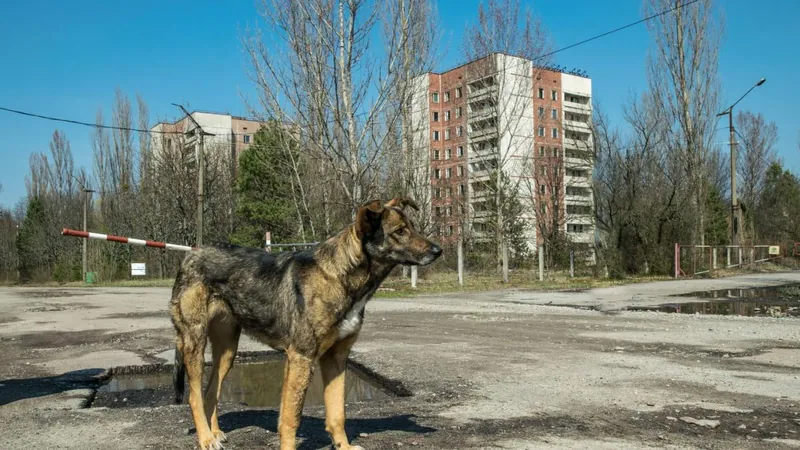
Chernobyl's Stray Dogs: The Genetic Mystery Unraveled by New Research
2025-01-17
Author: Kai
Chernobyl's Stray Dogs: The Genetic Mystery Unraveled by New Research
For nearly four decades, the Chernobyl Exclusion Zone (CEZ) has served as an unintended laboratory for researchers investigating the long-term effects of radiation exposure. One of the most intriguing subjects of study is the stray dog population that remained after the 1986 nuclear disaster, which has exhibited noticeable genetic differences from dogs in surrounding areas.
Recent research challenges the popular theory that radiation mutations are to blame for these genetic variations. A groundbreaking study conducted by scientists from North Carolina State University and Columbia University revealed that the changes in the dogs' genetics may be more accurately attributed to selective pressures and a variety of environmental toxins that have accumulated over the years, particularly due to cleanup efforts following the disaster.
The Chernobyl disaster, which occurred on April 26, 1986, marked a catastrophic moment in history. The region, once part of the Soviet Union, is now located in Ukraine, where a vast protective dome called the New Safe Confinement has been erected over the compromised reactor. Nearly 40 years later, the landscape is still profoundly affected, but life—particularly the lives of stray dogs—persists in unexpected ways.
Scientists have long been fascinated by the dogs that remained in the CEZ after the initial evacuation. Previous examinations indicated significant genetic differences between these dogs and those in nearby Chernobyl City. However, the root causes of these differences remained unclear, as researchers contended with challenges in determining whether radiation or other environmental factors were at play in the genetic disparities.
In a significant leap forward, the new study published in PLOS One employs advanced genetic analysis techniques, focusing on the genomic makeup and chromosomal structures of these dogs. The researchers found no evidence of mutations attributable to radiation exposure. Matthew Breen, a senior author from North Carolina State University, explained the team’s methods, noting that they examined populations separated by only 16 kilometers but found them to be genetically distinct. They posited that years of low-level exposure to various environmental toxins might better explain the genetic differences observed.
To validate their findings, the team established a baseline by analyzing the genomes of Chernobyl City dogs, which lie just outside the exclusion zone, as a control group. This comparison offered insights despite the significant generational gaps—over 30 generations—between today’s dogs and those that experienced the disaster firsthand.
While the absence of radiation-induced mutations simplifies some aspects of the investigation, the mystery of the dogs’ genetic makeup is far from resolved. The CEZ has been subject to contamination from not only radiation but also heavy metals, pesticides, and asbestos—some induced by cleanup activities. The researchers also speculate that the original dogs might have had pre-existing genetic traits that made survival in a hazardous environment more likely.
Lead author, Megan DilIon, highlighted the potential for extreme selective pressures influencing the dog population's genetic evolution. 'It’s possible that the surviving dogs, separated from the city population, were better adapted to their environment,' she remarked. The researchers are now focusing on investigating these dynamics more deeply.
As scientists continue to uncover the secrets of Chernobyl’s stray dogs, the implications of their findings extend beyond the immediate area and touch on larger environmental themes regarding adaptation and survival in post-disaster ecosystems. This research adds a compelling chapter to the broader story of life’s resilience amidst adversity.


 Brasil (PT)
Brasil (PT)
 Canada (EN)
Canada (EN)
 Chile (ES)
Chile (ES)
 Česko (CS)
Česko (CS)
 대한민국 (KO)
대한민국 (KO)
 España (ES)
España (ES)
 France (FR)
France (FR)
 Hong Kong (EN)
Hong Kong (EN)
 Italia (IT)
Italia (IT)
 日本 (JA)
日本 (JA)
 Magyarország (HU)
Magyarország (HU)
 Norge (NO)
Norge (NO)
 Polska (PL)
Polska (PL)
 Schweiz (DE)
Schweiz (DE)
 Singapore (EN)
Singapore (EN)
 Sverige (SV)
Sverige (SV)
 Suomi (FI)
Suomi (FI)
 Türkiye (TR)
Türkiye (TR)
 الإمارات العربية المتحدة (AR)
الإمارات العربية المتحدة (AR)